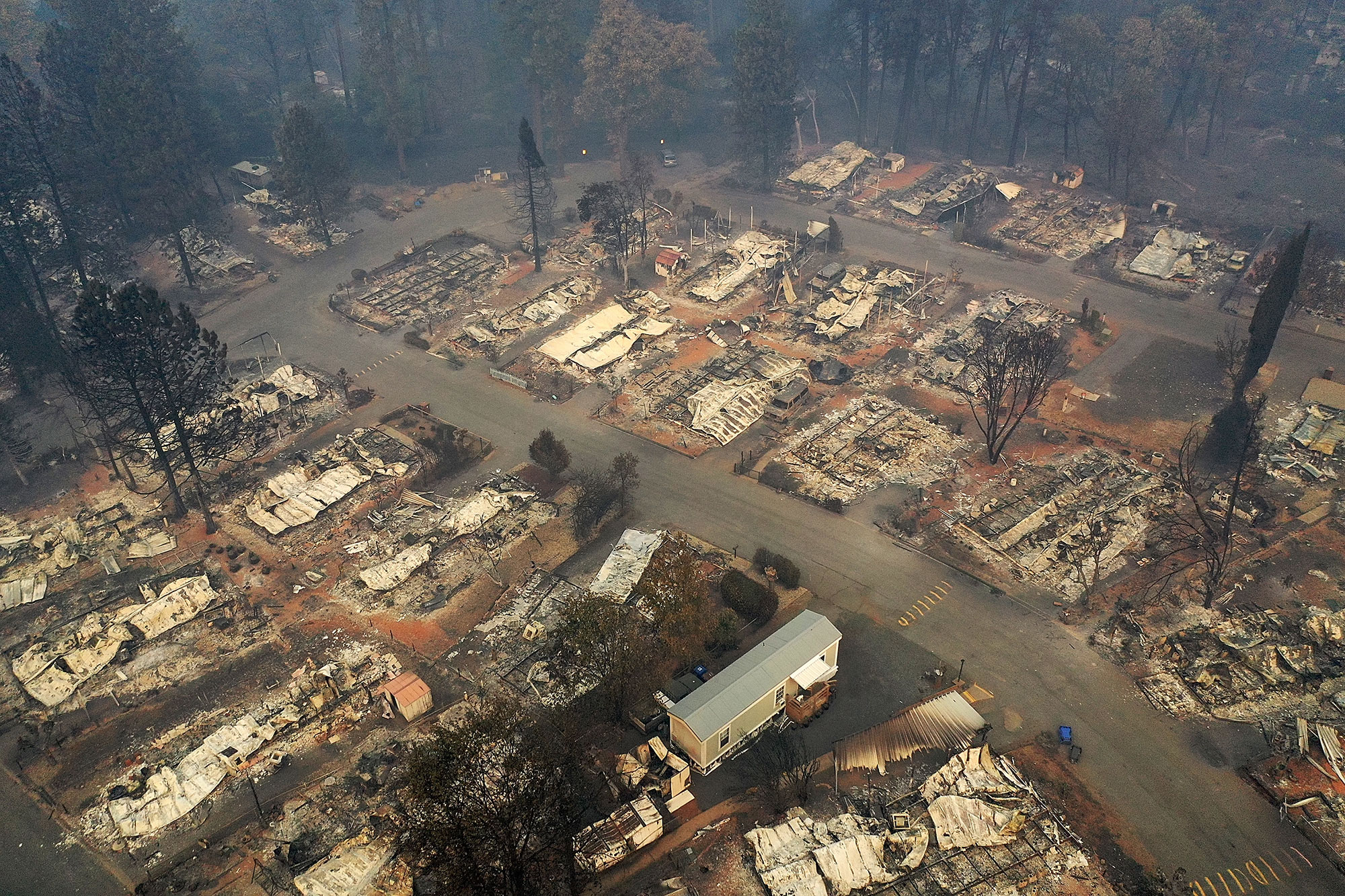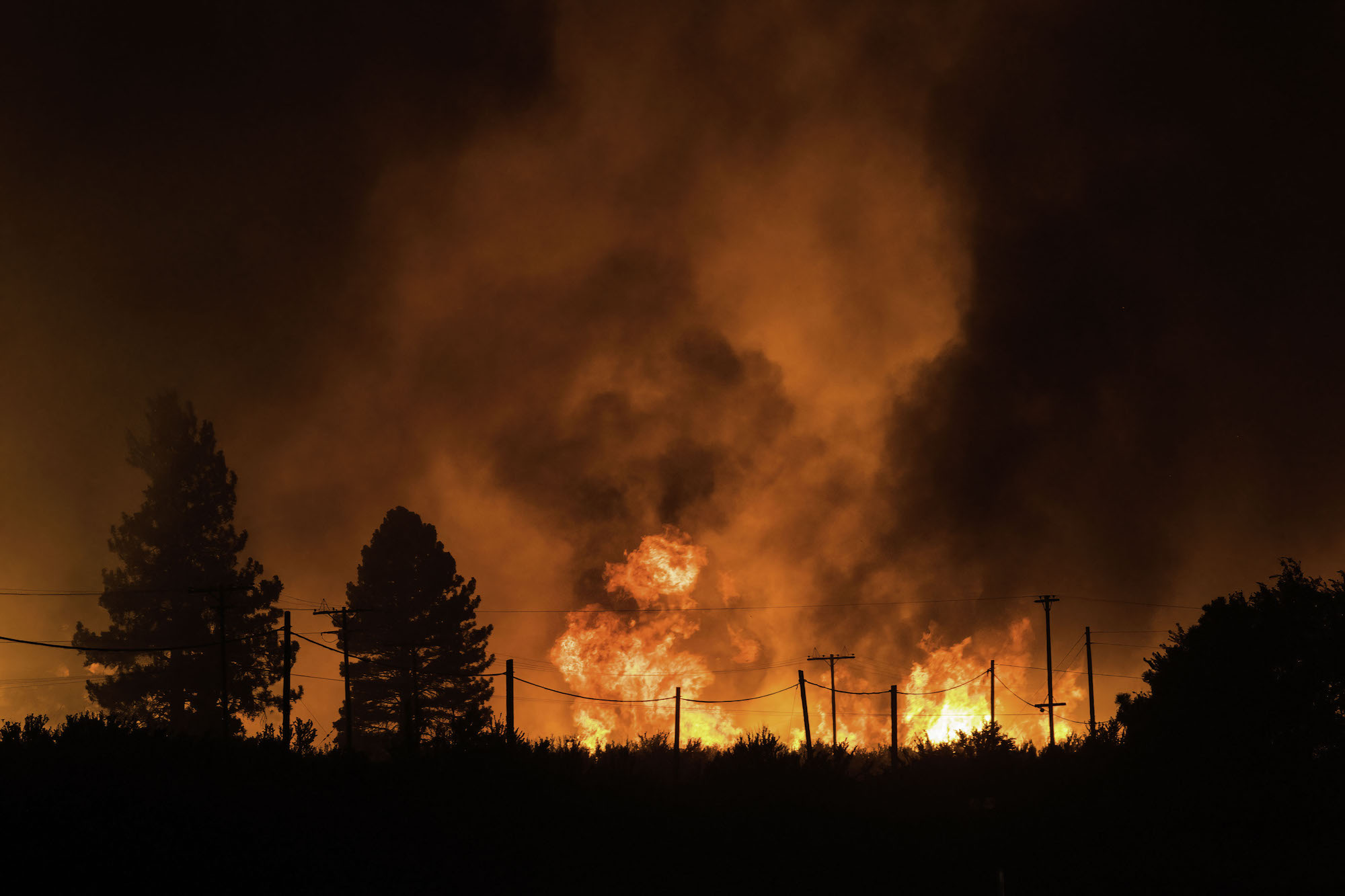On July 18, California’s Pacific Gas & Electric revealed that its electrical equipment might have sparked the Dixie Fire, a blaze that has since become the second-largest in the state’s history, torching 700,000 acres and destroying more than 1,200 structures. Three days later, PG&E, which emerged from bankruptcy last year after amassing some $30 billion worth of liabilities from wildfires, announced something more surprising: To prevent future blazes, the state’s largest utility plans to rip out 10,000 miles of overhead power lines in high fire risk areas and bury them underground.
The plan caps a years-long push by utilities to bury more power lines in the face of worsening weather and rising risks from climate change. According to PG&E, it’s the largest such effort ever announced by a U.S. utility: Pattie Poppe, the company’s CEO, described as a “moonshot” on a call with reporters, But whether PG&E can turn its announcement into action is a big “if,” as the utility has not estimated a timeline for the project, and it’s not clear that the benefits will outweigh the multi-billion dollar cost.
PG&E’s announcement, nearly two years after its equipment sparked the deadly Camp Fire, was “a clear recognition that something has to change,” said Julie McNamara, a senior energy analyst at the Union of Concerned Scientists. “But if this is not part of a holistic plan that is clearly reckoning with all of the challenges afoot, then this is a distraction.”

Burying power lines isn’t a new idea. The majority of electrical distribution lines, as well as the larger, higher voltage transmission lines that carry electrons over longer distances, remain overhead, said Sadrul Ula, an energy infrastructure researcher at the University of California, Riverside. But utilities have long buried lines in city centers, as well as parks and recreation areas like golf courses, largely for aesthetic reasons. Even though it can cost as much as ten times more than installing power lines overhead, utilities are now burying an increasing number of new lines. That includes power lines serving nearly all new residential and commercial developments in the U.S. They do it to meet customer preferences, help keep the lights on, reduce maintenance needs, and to protect against the growing threat of extreme weather.
Today, McNamara says, whenever a storm knocks out power lines and triggers outages, it kicks off a debate about whether the lines should be rebuilt underground. Similarly, as fire season worsens across the West and power lines are implicated in a growing number of destructive blazes, utilities are feeling pressure to move more of their equipment below ground.
Once buried, the risk of power lines starting fires is “very minimal,” Ula says. From that perspective, placing lines underground is a highly effective wildfire mitigation strategy. But the high cost means that companies rarely treat it as a silver bullet, instead using line burial in combination with cheaper retrofitting strategies, routine equipment maintenance, and vegetation clearing.
After its equipment sparked a series of deadly blazes in 2007, San Diego Gas and Electric launched a $3 billion effort to reduce wildfire risk that included “strategically undergrounding ” high-risk lines, flameproofing existing infrastructure by coating it in fire-resistant materials, and deploying sensors that shut off power to broken lines before they hit the ground. Portland General Electric and Puget Sound Energy, the largest utilities in Oregon and Washington state, respectively, are employing a similar set of strategies to help prevent their equipment starting fires, their spokespeople told Grist.
A spokesperson for Puget Sound Energy called burying power lines a “potential approach” that must be balanced with lower cost moves, like coating wires in insulating materials or replacing wooden poles with fire-resistant metal ones. Many factors go into determining whether a line is suitable for burial, with certain landscapes, like open farmland, posing fewer logistical challenges than areas with mountains and rivers, said Andrea Platt, a spokesperson for Portland General Electric.
“There’s an overlay of municipal codes and also easements and right of ways that all play a role, too,” Platt wrote in an email. “Since the costs of undergrounding are reflected in customer prices, we try to be judicious.”
When utilities do bury lines to reduce wildfire risk, their efforts tend to be measured in tens of miles rather than thousands. Since 2007, San Diego Gas and Electric has put 30 miles of high-risk lines underground as part of its wildfire strategy. It plans to bury an additional 25 miles this year, part of a ramp-up driven by the growing necessity of “public safety power shutoffs” to prevent overhead equipment from sparking fires. On a quarterly earnings call with investors last month, Poppe of PG&E said that the company is currently burying about 70 miles of power lines a year.
These numbers raise questions about how long it will take PG&E to hit its goal of getting 10,000 miles of high-risk lines in the ground. (At its current rate, it would take the company 143 years.) James Noonan, a PG&E spokesperson, told Grist that the company is focused on a “near term ramp up” and that within a few years, it hopes to be burying “well over 1,000 miles” of lines a year. While PG&E estimates it has more than 25,000 miles of power lines in state-designated “high fire-threat districts,” Noonan said it will focus on those in “elevated” and “extreme” zones of fire risk.

Perhaps the most important unanswered question about PG&E’s proposal is how much it will cost. In a June 30 filing to the California Public Utility Commission, the state agency that regulates privately owned utilities, the company projected that the cost of undergrounding lines in Butte County, an area ravaged by the North Complex fire last year, would be more than $4 million a mile through 2025. But Poppe told investors last month that the utility has “absolute evidence” that it can accomplish its larger goal for $2 million a mile, or $20 billion total, saying its rebuilding efforts in Butte County “cracked the code” on cheaper methods. The three weeks between that filing and PG&E’s announcement in July are “a short amount of time to have found such great savings,” said Mark Toney, who heads The Utility Reform Network, a California-based consumer advocacy group. Toney added that PG&E hasn’t filed any formal proposals with the commission detailing its plan, so it’s unclear where the savings would come from.
In response to questions from Grist, Noonan said that projects like the one in Butte County are “enabling the acceleration and expansion of undergrounding projects” by “showing us where we can be more efficient,” but declined to offer specifics. Poppe told investors that PG&E would be releasing more information in February, when the company files an annual update on its wildfire mitigation efforts.
What seems clear is that at least some of the cost of the project will be passed on to PG&E’s customers: Noonan said that the company will “leverage customer and public funding” to pay for power line burials. But that cost will eventually be largely offset by reduced need for fireproofing overhead equipment and clearing vegetation, Noonan said, tasks which are together “on par with the cost of undergrounding on a per mile basis.”
Toney is less optimistic. He worries that by diverting funds away from routine equipment maintenance and vegetation clearing — responsibilities the utility has a history of shirking — in order to bury more lines, the utility could inadvertently create more fire risk at the same time that it’s raising electric bills. Higher rates, in turn, could hinder the state’s attempts to slash carbon emissions, if rising electricity prices make residents reconsider switching to electric vehicles and appliances.
The California Public Utility Commission has the final say over any rate increases PG&E proposes. Terrie Prosper, a spokesperson for the commission, declined to say whether the regulator would consider allowing PG&E to raise rates to pay for the proposal but said it would “work with stakeholders, including PG&E, in a public process to ensure that the utility is making safety investments that are in the best interest of their customers and all Californians.”
If PG&E wants to make communities safer and more resilient to the changes ahead, its new proposal “has to be part of a fully integrated plan” that meets the challenges of our future climate in a way that is just and equitable, said McNamara of the Union of Concerned Scientists. “What that ultimately looks like, what the stakeholder process is, how high risk areas are prioritized, these are all open questions and critically important to get right.”



